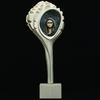Mate to Frick Museum's Carved French Walnut Renaissance Cabinet Acquired by Rau Antiques
- NEW ORLEANS, Louisiana
- /
- November 08, 2010

If this "dressoir" could talk...
Harpies, satyrs, masks and curvaceous females were all familiar motifs on decorative arts in the 16th century. But what's a harpy? In Greek mythology, a harpy derived its name from the Greek verb "to snatch," and harpies were often depicted in ancient times as beautiful winged maidens-bomb-shell babes-whose reputation for stealing food from the gods got them important placement on decorative arts and furniture.
The uniqueness of this spectacular Renaissance cabinet or sideboard, also called a "dressoir" in French, is that it is the exact twin to the one already in The Frick Collection in New York. This cabinet, one of two, had been recently acquired by Bill Rau of Rau Antiques after an equally fortuitous and circuitous search. A third similar cabinet is in the Victoria and Albert Museum.
One of the twin cabinets was originally purchased by Henry Clay Frick, the industrialist whose business partner was steel magnate Andrew Carnegie, from the famed English dealer Sir Joseph Duveen in 1917 for $110,000 (or $26,300,000 in today's GDP), according to a copy of the original invoice. Even back then, during WWII, this purchase put the Frick cabinet as the world's most expensive piece of furniture to ever sell anywhere. In today's market, this piece of furniture is worth more any furniture from Versailles.

What happened to the matching cabinet along the way of its being acquired by Bill Rau adds another layer of mystery and interest. Both cabinets were crafted in French walnut by the same furniture maker and in the same atelier belonging to the celebrated 16th century French architect Jacques Androuet Ducreceau. Crafted of French walnut, it measures 65" high by 72.5" wide by 23" deep, and the doors on the top still open perfectly, and the three drawers all pull out.
The twin cabinets are a visual dictionary of 16th century style: harpies, female anatomy, architectural motifs, depth perspectives, satyrs, masks and strap work. In 1845, the cabinets showed up in a furniture restorer's workshop in Marseilles to repair some wood damage, especially on the backside, before they both showed up in a major collection in Europe that was purchased by Sir Joseph Duveen. This collection of furnishings ended up costing Duveen $1,500,000 dollars and his purchase was reported by major newspapers everywhere. One of the cabinets went directly to Number One 70th Street, in New York, for Mr. Frick's approval.
What happened to the stray twin? It went its separate way until Bill Rau received a phone call in 1996 from a collector who owned the matching cabinet. The owner asked Rau if he had access to the antiques book, "World Furniture," considered the textbook for serious antique furniture dealers. On page 42 is a rendering of the very same cabinet. Unable to convince the owner to part with the cabinet that year, Rau knew he'd be able to get it eventually, as the owner grew older and started consolidating his collection.
For more information and images: www.rauantiques.com

270x400_c.jpg)



10270x400_c.jpg)














![Peter Paul Rubens (Flemish, 1577–1640), After Titian (Tiziano Vecelli) (Italian [Venetian], c. 1488–1576), Rape of Europa, 1628–29. Oil on canvas, 71 7/8 x 79 3/8 in. Peter Paul Rubens (Flemish, 1577–1640), After Titian (Tiziano Vecelli) (Italian [Venetian], c. 1488–1576), Rape of Europa, 1628–29. Oil on canvas, 71 7/8 x 79 3/8 in.](/images/c/e2/2e/Jan20_Rape_of_Europa100x100_c.jpg)
